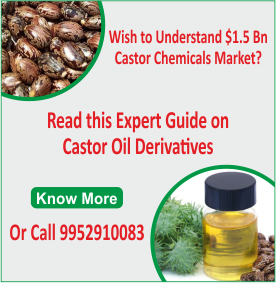Castor Oil & Derivatives Industry & Trade
CastorOil.in provides you links & resources related to castor, castor oil, castor derivatives & castor oil producers. We hope to make this a one-stop resource for all info about castor and castor products, and hope that you find this site to be of use.
This section of Castoroil.in provides details about the industry & trade scenario for castor oil & castor chemicals.
Castor Production & Trade
World Castor Scenario
- The world castor seed production is over 1 million tons per annum. India is major producer with over 60 % share, followed by China and Brazil with about 20% and 10 % respectively. Some other countries that produce small amounts of castor beans are West Indies and some regions of Africa.
- America uses about 40% of the castor oil & derivatives produced, and they import 90% of their consumption. Castor plants have not been farmed on a commercial scale in the United States since the early 1970s.
- Market Influencing Factors in Castor Trade
- Crop development based on monsoon progress in key growing regions
- Domestic demand for castor oil from the major cities & export demand of castor oil
- Variations in castor seed domestic acreage, based on yield and price realization
- Indian, Chinese and Brazilian crop sizes
- Comparative price with other vegetable oils in the domestic market
- The castor seed price tends to firm up during the planting period and eases down during the harvesting period. Prices tend to show significant inter-seasonal variations
- Castor seed growers and crushers hoard the commodity before selling in expectation of better prices.
- Characteristics of Castor Seed and Oil Market
- Uncertain supply - The world castor seed production has fluctuated between 1.2 and 1.8 million tonnes since 1997 to 2001. India's production ranged between 0.8 and 1.1 million tonnes during the same period.
- Recent developments of artificial substitutes of castor oil in the world market has subjected the demand to fluctuation
- Long storing period - It is a common practice for the castor seed growers and crushers to hoard the commodity before selling in expectation for better prices.
- Well-developed and organized spot market in India
Indian Castor Trade Scenario
· India Castor Trading Facts
o Castor is cultivated for the commercial importance of its oil.
o India is the world leader in castor seed and oil production and dominates the international castor oil trade
o The Indian variety of castor has 48 % oil content of which 42% can be extracted, while the cake retains the rest.
o India's castor production fluctuates between 0.6 to 1 million tonnes a year.
o The state of Gujarat accounts for over 80% of India's castor seed production , followed by Andhra Pradesh and Rajasthan . In Gujarat, castor is mainly grown in the Mehsana, Banaskantha and Saurashtra/Kutch. In Andhra Pradesh, the main castor growing areas are Nalgonda and Mahboobnagar districts.
o Castor is a Kharif crop. Its sowing season of castor is from July to October and the harvesting season is from October to April.
o India's annually exports around quarter million tons of commercial castor oil, 1,50,000 tons of castor seed extractions (castor meal), and about 20,000 tons of castor seed.
o The domestic ready market is quite well developed in Gujarat and Andhra Pradesh. The major “mandi” prices near the producing centers, upcountry prices and export prices from ports are available on a daily basis in public domain. The price dissemination is also up to the mark due to the export orientation of the commodity
- Major Castor Trading
Centers in India
The major castor oil markets in India are:
· Gujarat
o Rajkot
o Ahmedabad
o Gondal
o Gadwal
o Bhabar
· Andhra Pradesh
o Jedcherla
o Yemignoor
Castor Oil Storage, Packaging and Shelf Life
· Because the castor oil contains double bonds in its lipid structure, it is prone to an undesirable reaction called lipid oxidation. Lipid oxidation occurs when the double bonds in the fatty acid react with oxygen to form peroxides - this changes the chemical nature of the oil. There are many factors which influence the rate of oxidation in foods: fatty acid composition, free fatty acids versus the corresponding acylglycerols, oxygen concentration, temperature, pro-oxidants, radiant energy (visible and ultraviolet light), and the presence of antioxidants.
· Owing to the above reasons, castor oil is stored in a controlled environment. That includes removing oxygen, storing the oil in a cool place, placing the oil in an opaque container, removal of pro-oxidants (e.g., cobalt, copper, iron, manganese, and nickel), and possibly adding antioxidants. Castor oil is not as prone to oxidation as much as other oils unless exposed to high temperatures.








